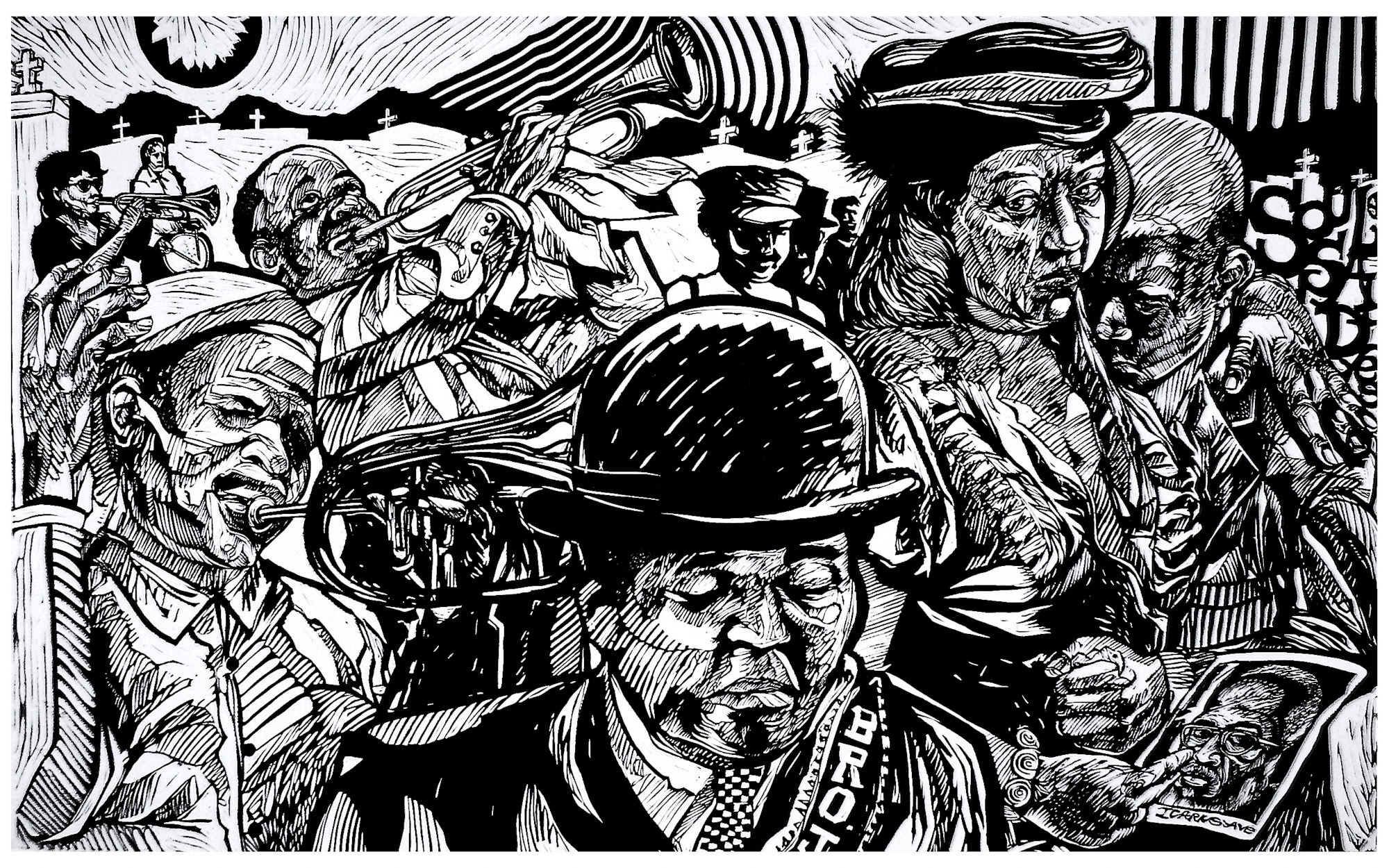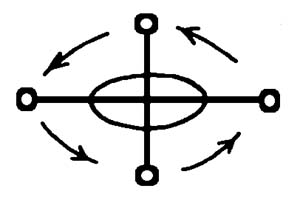Last semester, I worked as an undergraduate lab instructor in the physics department for Dr. McLean’s “The Science of Sound” course. I thoroughly enjoyed working in this position and feel that I learned a great deal from it, not only about the science of sound but about myself, as well. While working as a lab instructor for this lab granted me new skills and a passion for instructing, it also, unexpectedly, left me with tools I can now use to enrich my interpretations of Steve Prince’s art.
For example, when I look at Prince’s piece, “Requiem for Brother John,” I am instantly drawn to what I perceive to be sound waves emanating from the trumpet in the background. These waves remind me of my time spent working in the Science of Sound Lab and of the hours I spent grading students’ drawn representations of waves for accuracy (not artistry, though some of the waves were drawn with obvious skill and flair). Notably, the waves appear curved upon their immediate exit from the trumpet and then straighten out when they reach the left-hand corner of work, as waves do upon propagating far enough out.

Thus, Prince’s portrayal of what I perceive to be sound waves is accurate when weighed against my existing knowledge of the science of sound. However, Prince’s piece is not scientifically canonical insofar as that sound waves are usually not visible, without the help of an oscilloscope, that is. Prince’s simultaneous accurate depiction, but impossible visualization of sound waves creates an interesting tension within the piece, one that, for me, correlates to Joe Moran’s discussion of the divisions, but more importantly, the links, that exist between the humanities and the sciences.
Steve Prince’s latest lecture held at Geneseo, entitled, “Kitchen Talk,” saw him mention the piece I now consider. Prince said that “Requiem for Brother John” was inspired by the passing of someone who was very important to him. It is through integrating this knowledge and my perception of the presence of sound waves that I arrive at an interesting interpretation of Prince’s piece. I believe that the tension between the realism of the work, the accuracy of the sound waves, and their impossibleness in being present in the same sphere as ordinary men and women, creates a scene and a story that reminds me of W.E.B. Du Bois’ chapter, “On the Passing of the First-Born,” and leaves me again thinking of the yowa cross.
Indeed, W.E.B. Du Bois’ “On the Passing of the First-Born” painfully but beautifully recounts Du Bois’ experience losing his infant son. At the moment of his son’s death, Du Bois writes that his son’s “little soul leapt like a star that travels in the night and left a world of darkness in its train.” (Du Bois, 188) Du Bois’ preternatural depiction of the instant of his son’s death captures the significance of Du Bois’ loss. Additionally, Du Bois’ description of the departure of his young son’s soul, an event that cannot be visualized, at least with human eyes, mirrors Prince’s artistic representation of the sound waves that are also invisible to the human eye.
Immediately after narrating the flight of his son’s soul, Du Bois writes that the “day changed not; the same tall trees peeped in at the windows, the same green grass glinted in the setting sun.”(Du Bois, 188) Here, Du Bois returns to portraying the physical world with realism, thereby contrasting the supernatural manner in which he describes his son’s death. This parallels the realistic style that Prince affords “Requiem for Brother John,” save for the jarringly present sound waves.
In both pieces, Du Bois and Prince juxtapose mysticism with realism and utilize the former to describe the deep, personal loss they both felt. Moreover, the supernatural elements Du Bois and Prince employ in their craft speak to aspects of the yowa cross as well as Dr. Lytton Smith’s discussion of “line.” Du Bois’ work, in particular, simultaneously blurs and enhances the line between life and death. Du Bois, by describing the departure of his son from the physical plane, establishes the boundary between life and death while also suggesting that his son is not gone, but has traveled into another world or different form.

It is in this way that Du Bois’ narration seems to illustrate the transitional arrows of the yowa cross, as his son’s journey from the land of the living, the earth, or ntoto, to the land of the dead, the white clay, or mpemba, is made visible by Du Bois’ words. Prince’s work also invokes the yowa cross through its inclusion of the sound waves, as their design physically resembles the individual components of the yowa cross. The sound waves that have immediately exited the trumpet bear resemblance to the transitional arrows that represent the potential pathway of Du Bois’ son, whereas the sound waves that have flattened out parallel the boundary lines that seem to separate the two worlds.
Returning, for a moment, to Dr. Smith’s focus on the word “line” and its definition, I remember remarking that many students, myself included, viewed lines as a kind of boundary. Indeed, the lines in the yowa cross separate the ntoto from the mpemba; however, these lines are at once subverted and reinforced by the arrows that transform the yowa cross into a circle. These arrows demonstrate that though the worlds are different, they are deeply connected, and that, regardless of which world one resides in currently, one is truly a member of both.
Just as the lines and the arrows are in a state of simultaneous conflict and harmony, Prince and Du Bois’ inclusion of the invisible, be it in the form of sound waves or souls, creates a sense of tension with the rest of their work, that, to me, ultimately serves to cohere the world of the living and the world of the dead. Perhaps Prince and Du Bois utilize this technique in order to cope with the aching loss both suffered that served as impetuses to their respective works, as it allowed them to each “understand the ways and powers of both worlds” and gain a sense of “wholeness,” despite their deep losses.
While my interpretations of the works of Prince and Du Bois led me to discuss relatively spiritual concepts, these works could nevertheless be interpreted secularly and still exist in conversation with the yowa cross. For example, the tension felt through Prince’s accurate representation of sound waves and the impossibleness of their presence within the realistic design of his art, could be viewed as an effort to link the sciences with the arts and thereby close the gap that many perceive exists between the two.
Furthermore, the geometry of the yowa cross latent within “Requiem for Brother John,” could lead an observer to consider the yowa cross, but from a secular stance. As previously mentioned, the yowa cross encouraged Bakongo peoples to understand the power and wholeness of both worlds. This idea can be extended and applied to art, literature, and even daily life, as the yowa cross inspires understanding and appreciation of contrasting entities.
Thus, if one should find that their interpretation of “Requiem for Brother John” is different from another’s, one could recognize that wholeness is achieved through understanding both worlds, that is both interpretations, and that there is much to be gained from attempting to grasp and appreciate another’s interpretation. Indeed, this idea, gained by the symbolism within the yowa cross, could inspire individuals to recognize the underlying wholeness of accepting and understanding differences, and thereby prevent them from furthering divides and escalating tensions.
